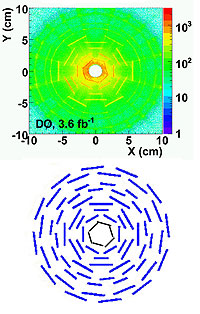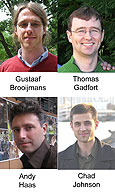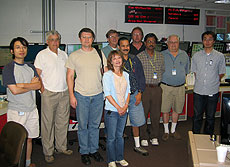Crazy enough?
 |
| Scientists searching for these kinds of particles looked for particles that originated many inches from the beam. The top plot shows where scientists observed particles' origins, while the bottom shows the geometry of DZero's inner detector. As DZero scientists expected, they found that particles often originated in the detector's material. These false signals were removed from the analysis. |
We all agree that your theory is crazy. But is it crazy enough? --Niels Bohr
I'd like to share a little secret with the Fermilab Today readership. For all that has been written about the Higgs boson, we don't know very much about it. We don't know its mass. We don't know how it decays. Indeed, we don't know if it even exists at all.
Given these facts, what do we know about the Higgs boson, and why is such a big fuss made about it? We know scientists can show that two fundamental forces - the electromagnetic force, which holds atoms together; and the weak force, which causes some kinds of radioactivity -are different sides of the same coin. The Standard Model has a possible explanation for why these two things are the same, and this explanation is called the Higgs mechanism. An outcome of this mechanism is that it predicts the Higgs boson.
However, there remains the very real possibility that something else explains the unification of the weak and the electromagnetic forces. For instance, models incorporating the principle of supersymmetry predict not one, but many Higgs bosons, with different spins, electric charge and many other properties.
Physical Review Letters has recently accepted a DZero paper that investigated a non-traditional Higgs boson. In this analysis, scientists compared data to a theory in which a Standard-Model-like Higgs boson decays in a very unconventional way. A recent series of models (called hidden valley models) predict a class of so-far-undiscovered particles into which a Higgs boson can decay. These models go on to further predict that these hypothetical particles live a long time. If particles live a long time, they travel a relatively long distance. So scientists looked for particles decaying many inches away from where they were created. Scientists found no evidence to support this specific model and have partially ruled it out. Once again, scientists using Tevatron data have tested a crazy idea. Could it be that it just wasn't crazy enough?
And the saga of the search for the Higgs boson continues.
-- Don Lincoln
 |
These analyzers were responsible for this measurement. All of them are from Columbia University. |

Successful long term operation of the silicon microstrip tracking detector requires the participation of a large team of experts. Many of the physicists currently contributing to this effort are shown in this photo from the DZero control room. From left to right: Zhenyu Ye, Ron Lipton, Peter Svoisky, Lynn Bagby, Marvin Johnson, Satish Desai, Mike Utes, Nirmalya Parua, Bill Cooper and Masato Aoki.
|